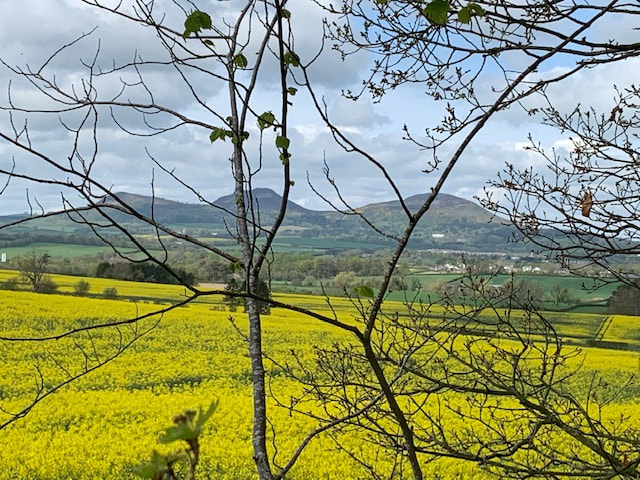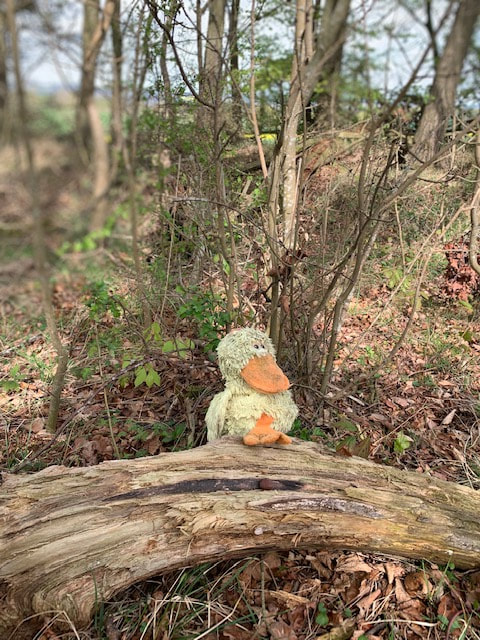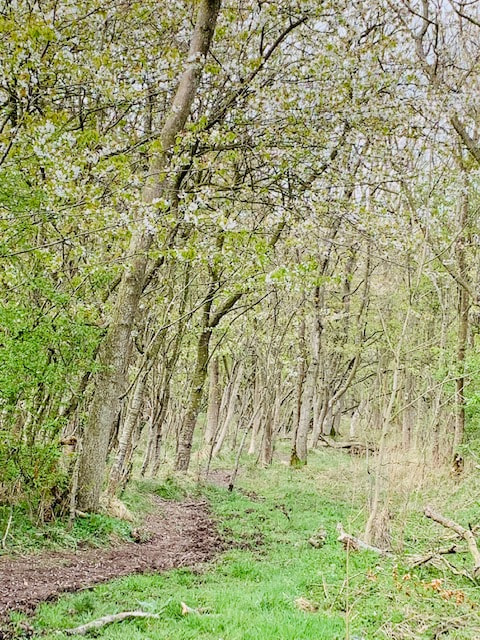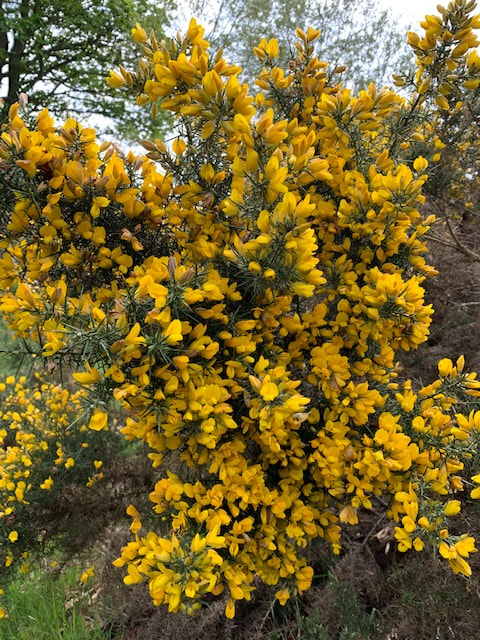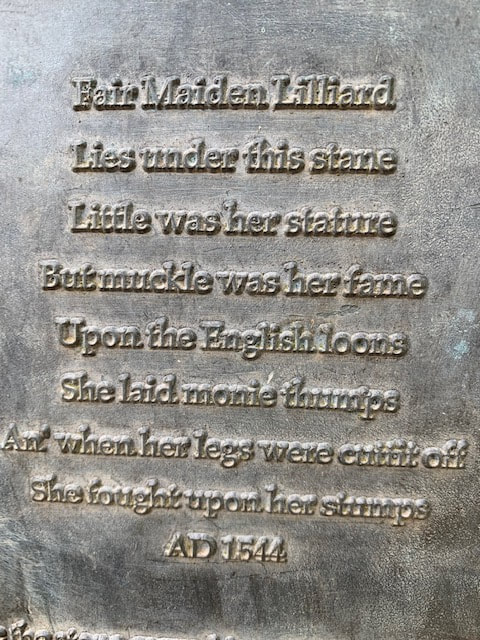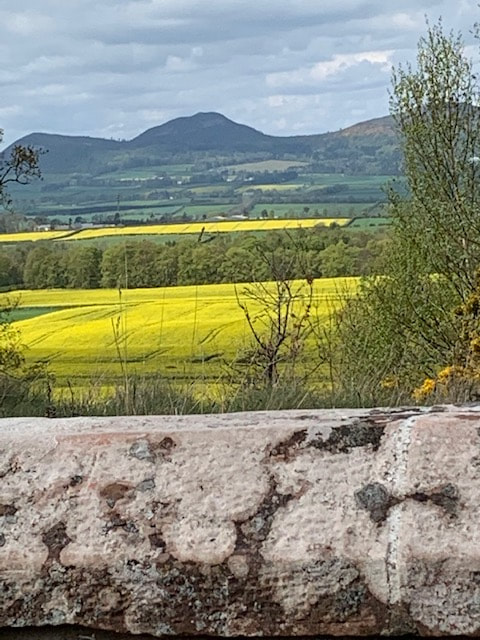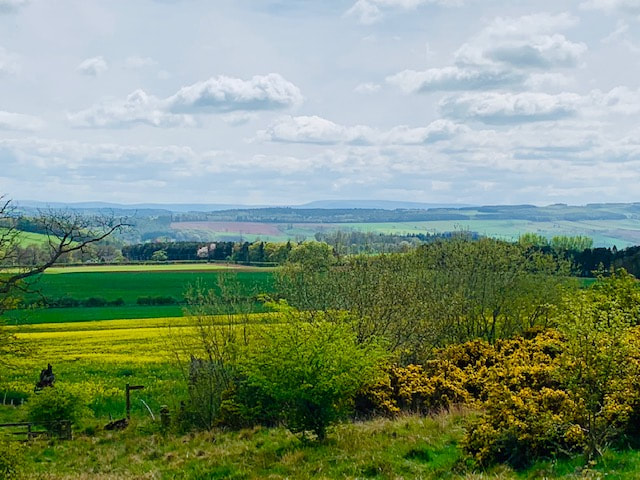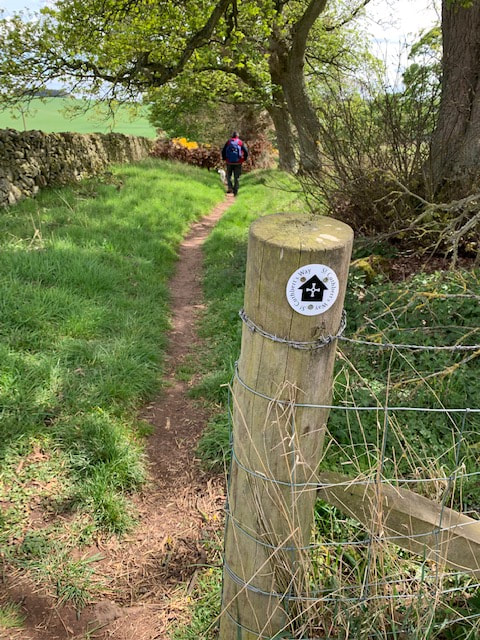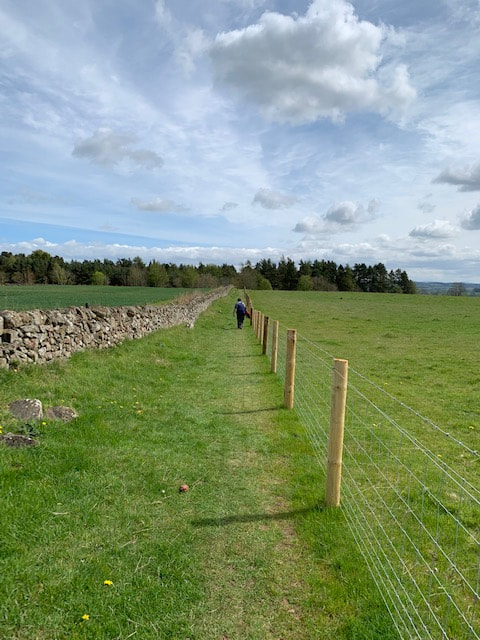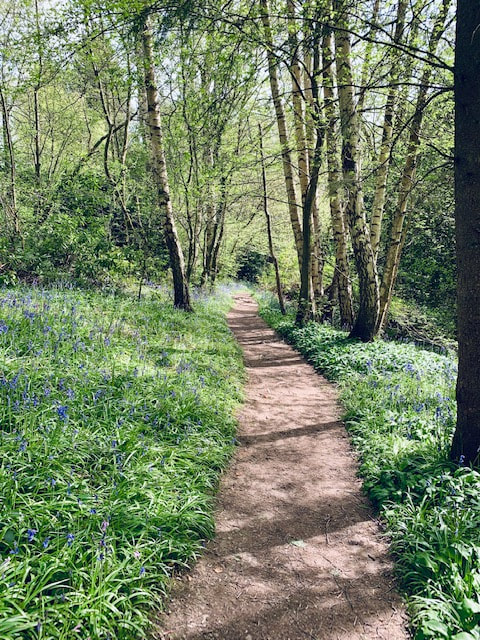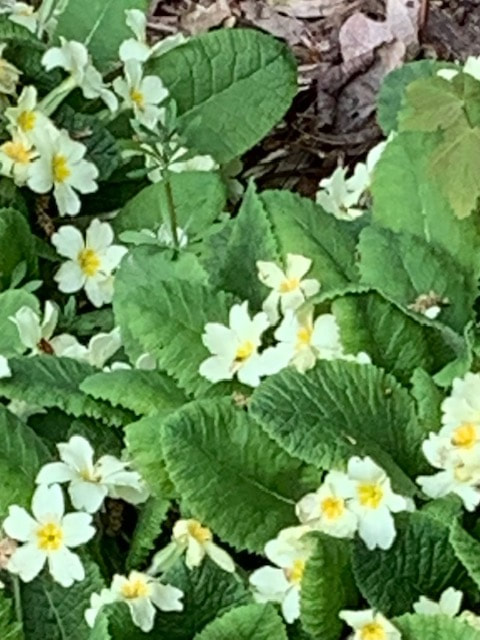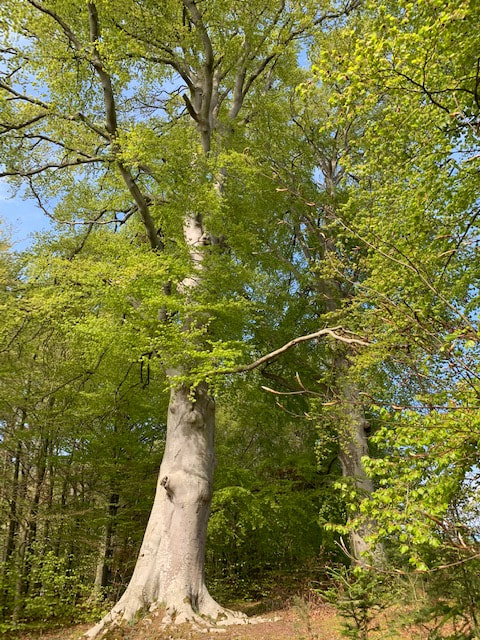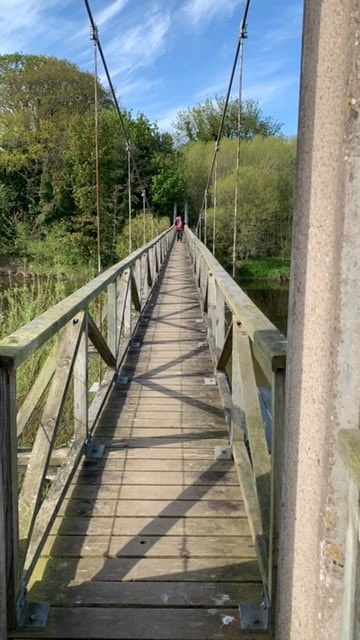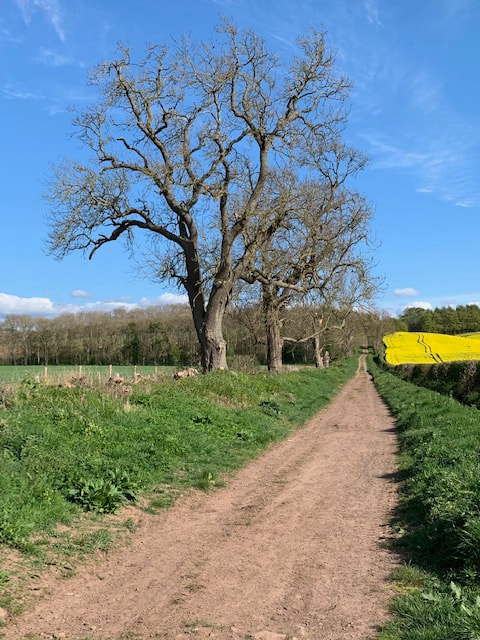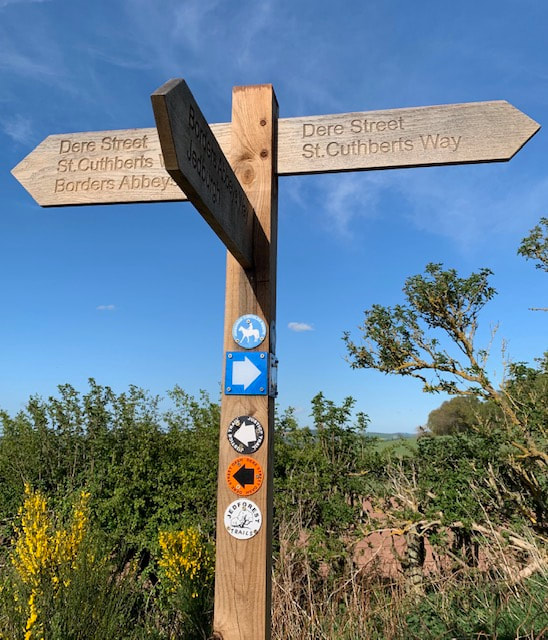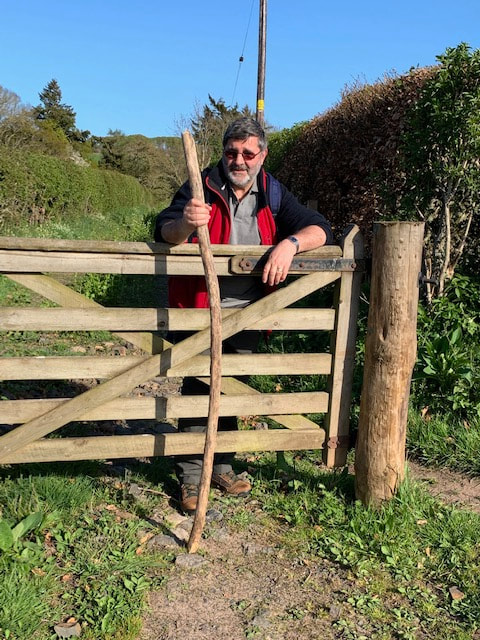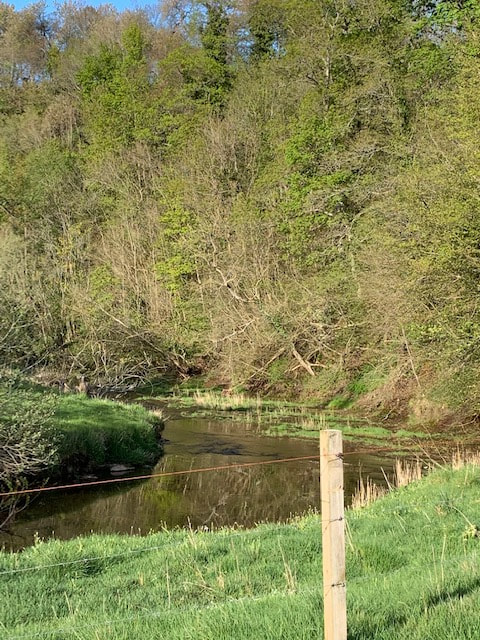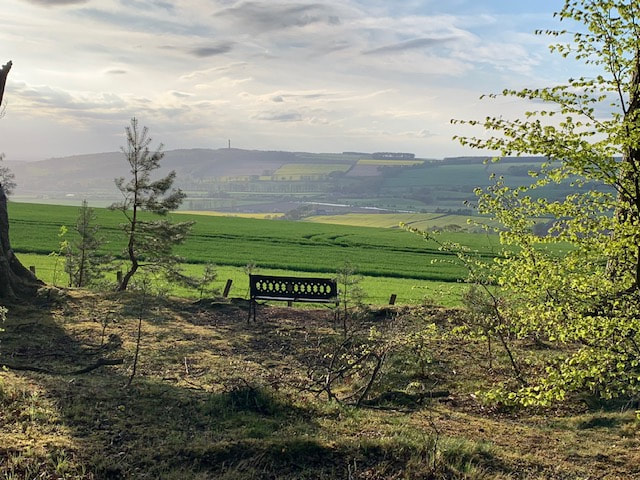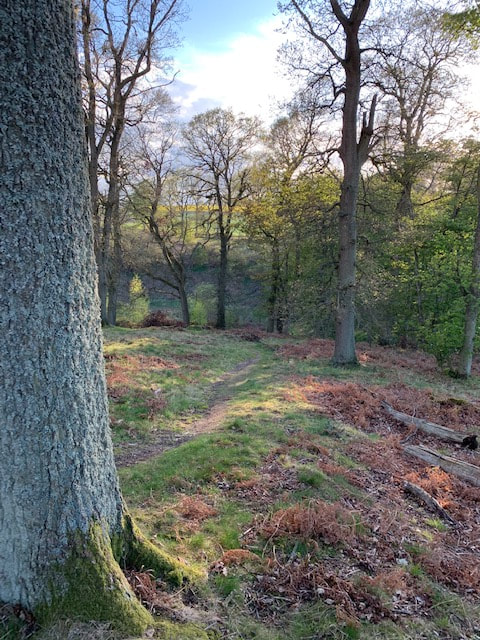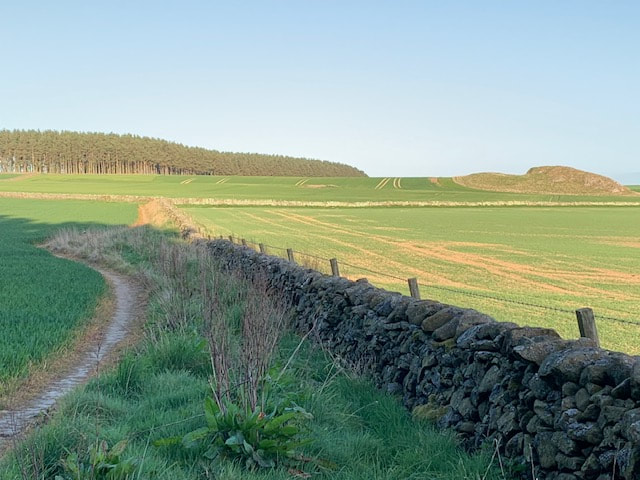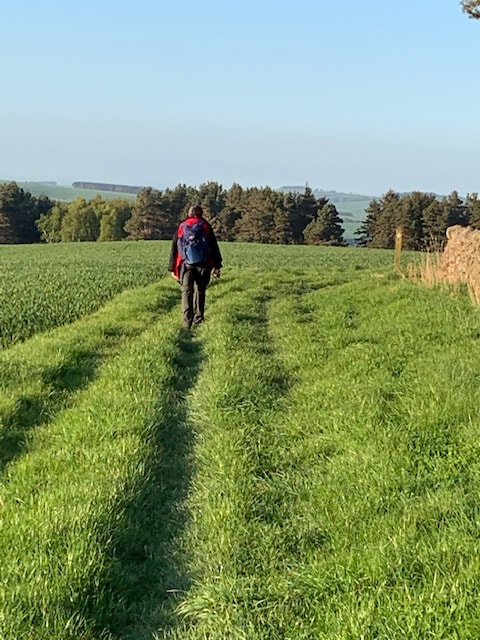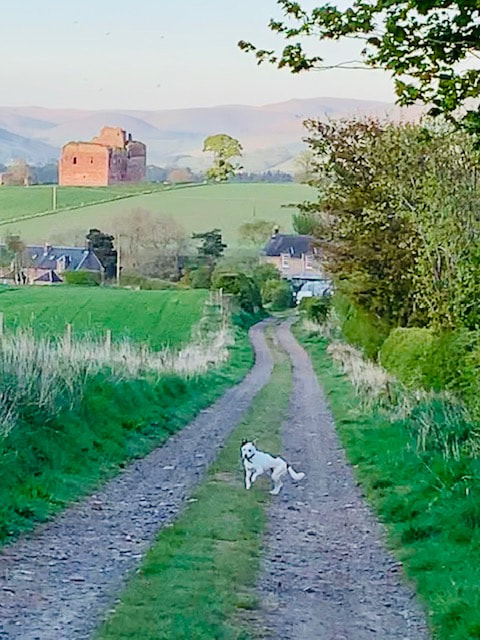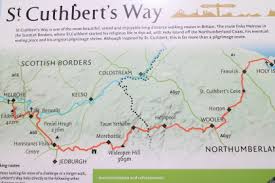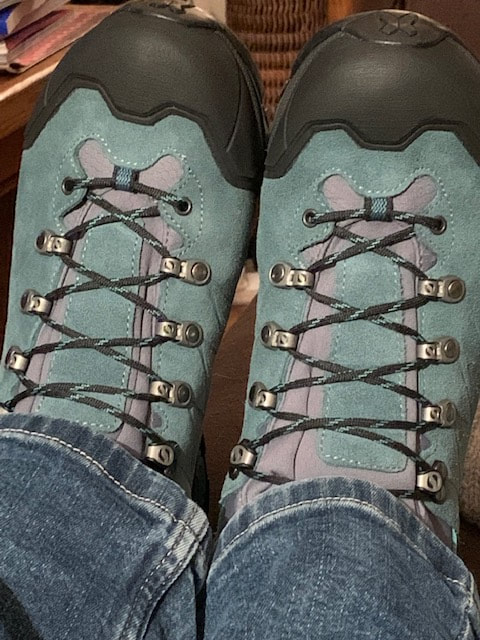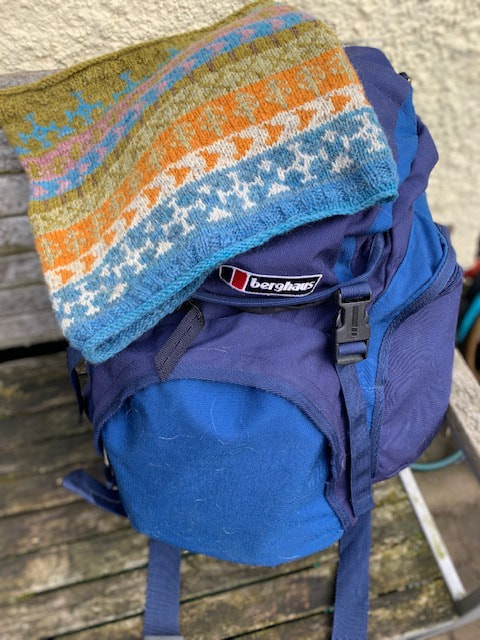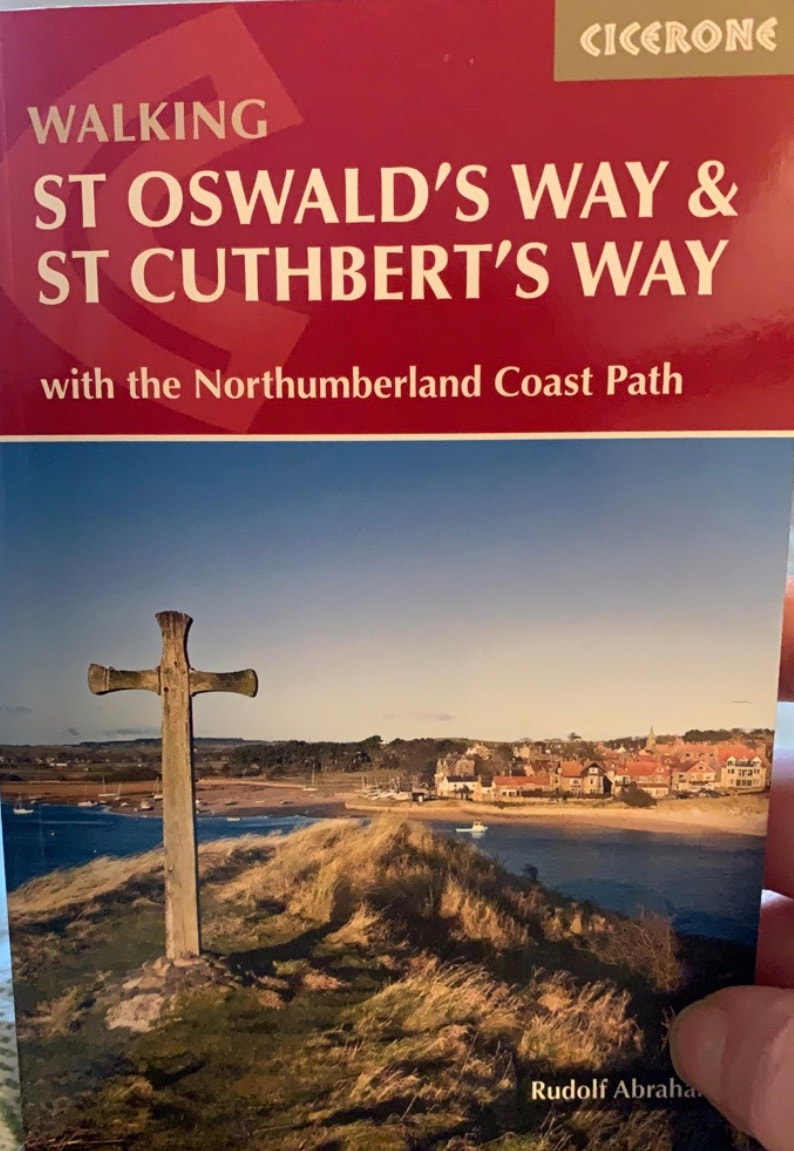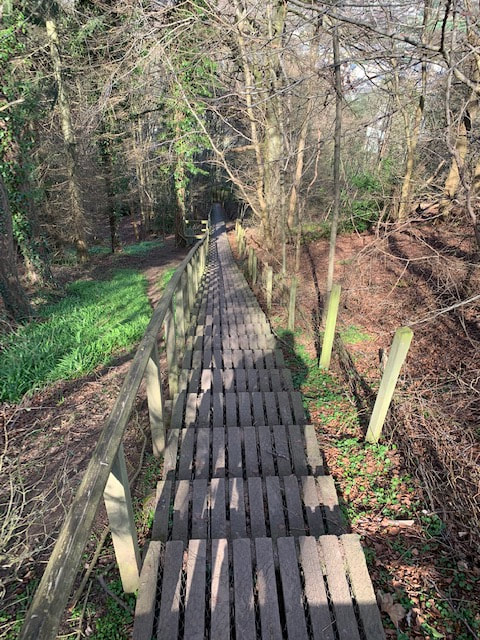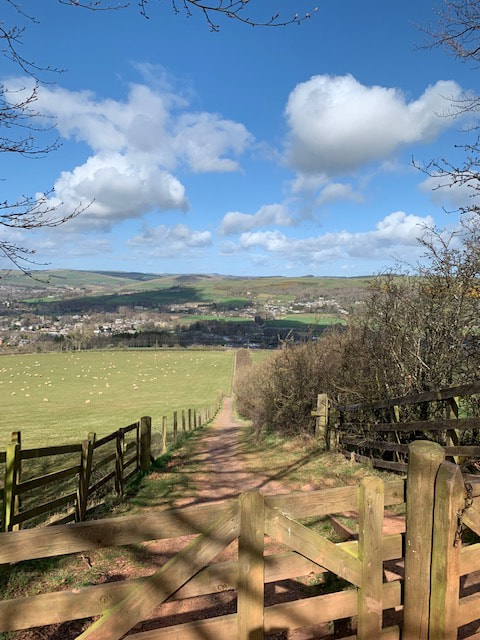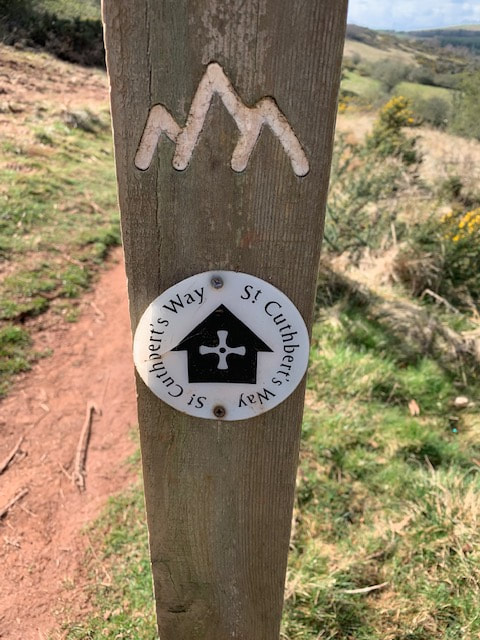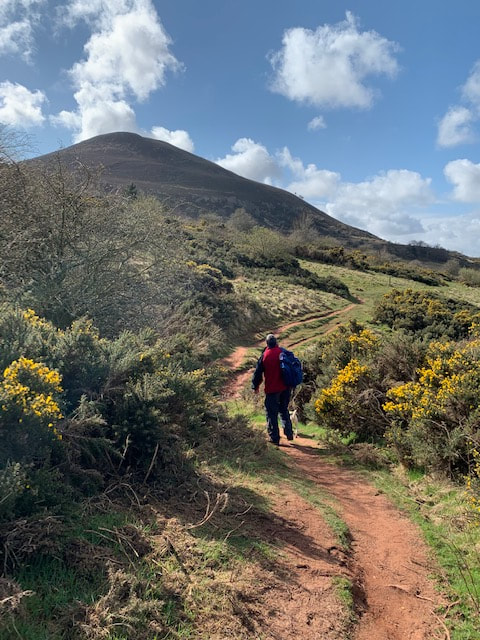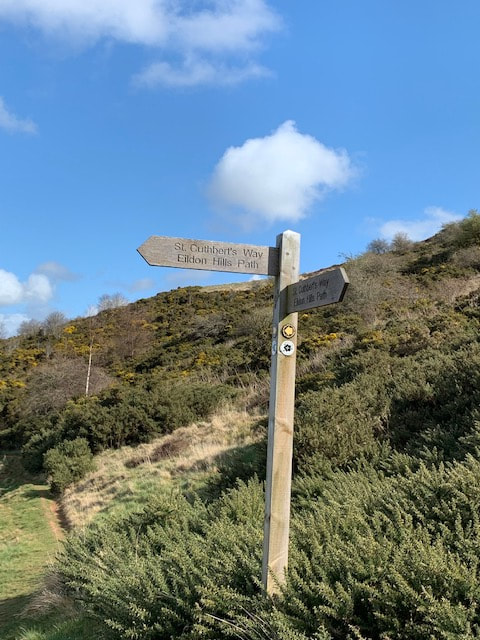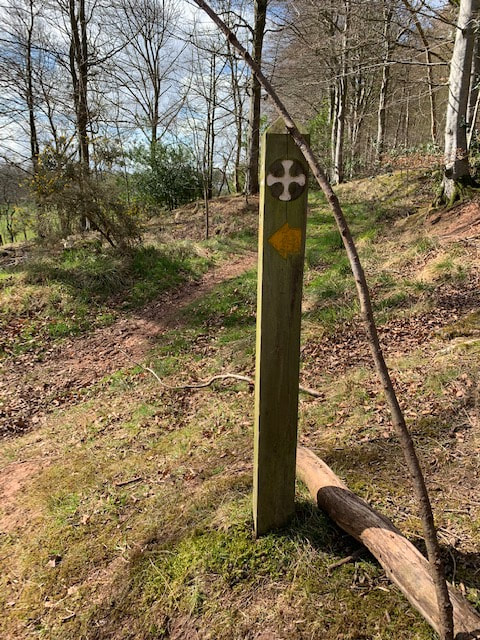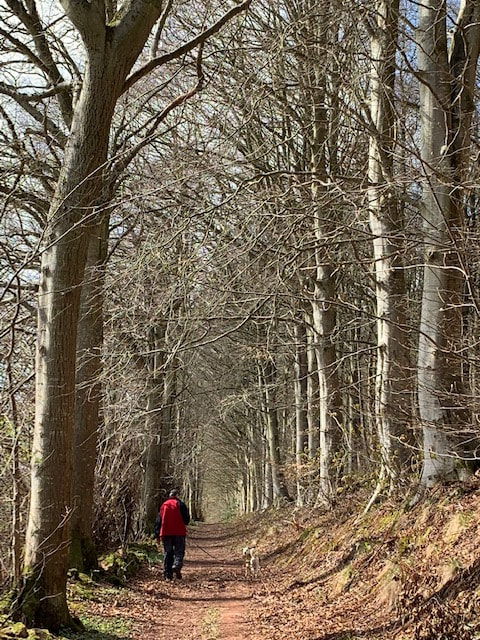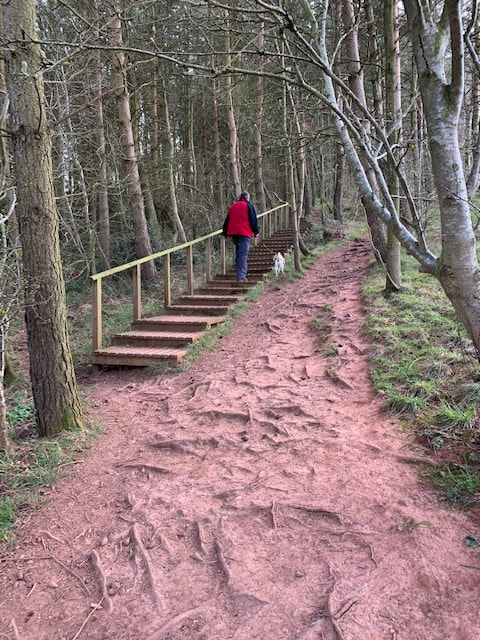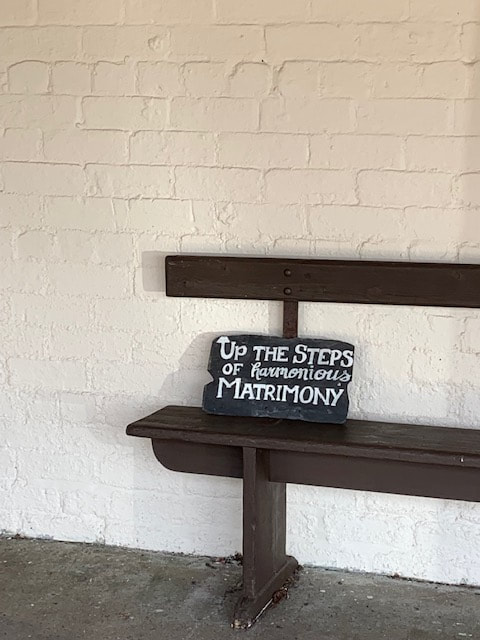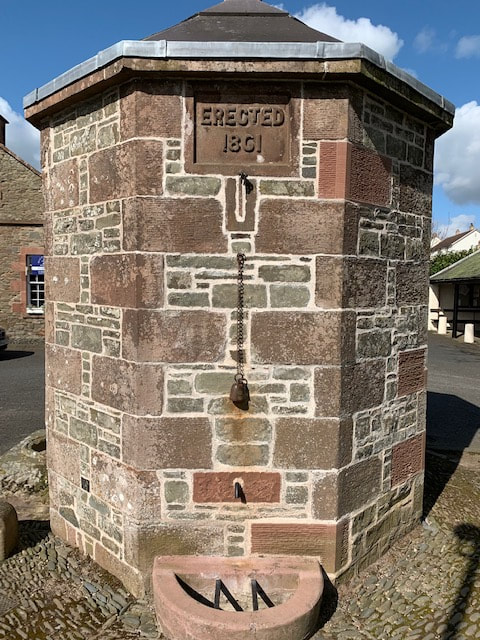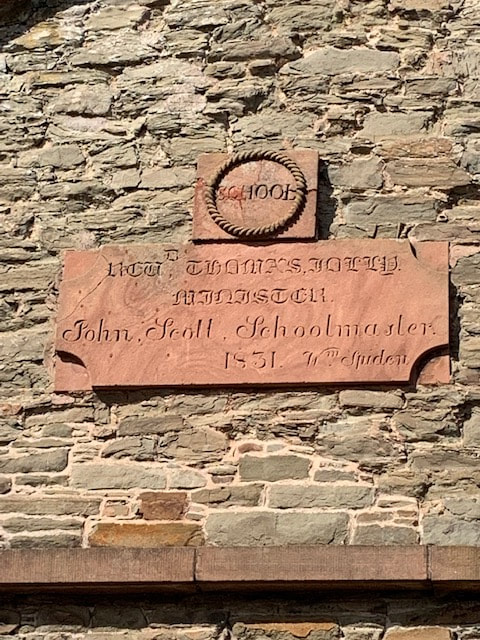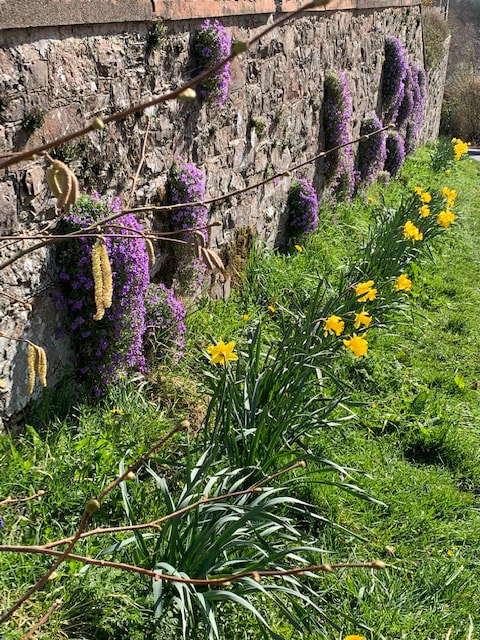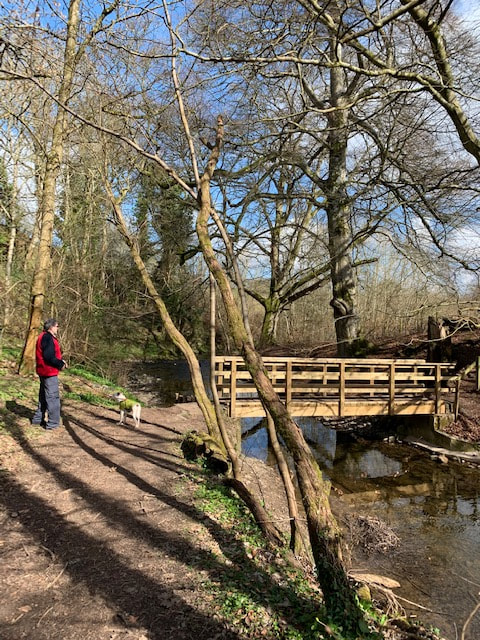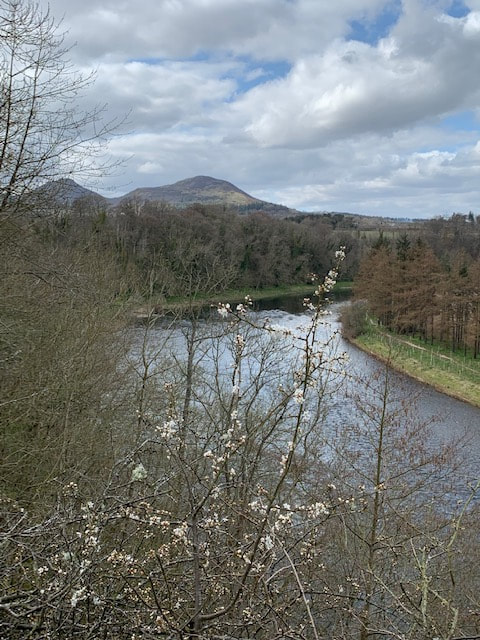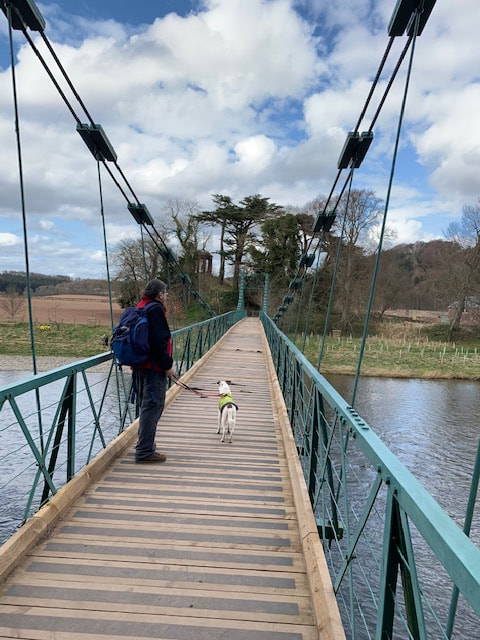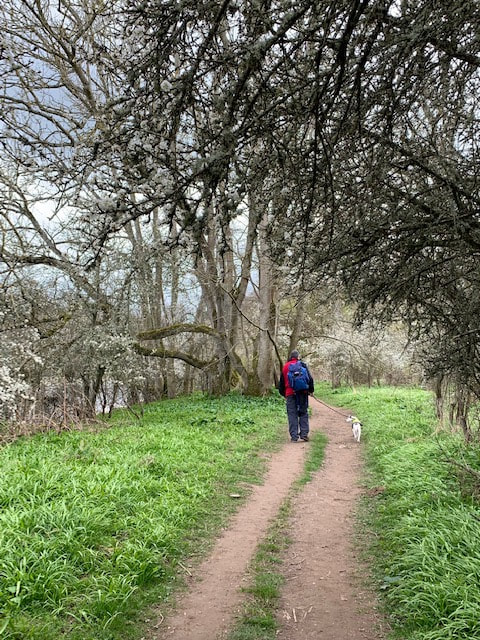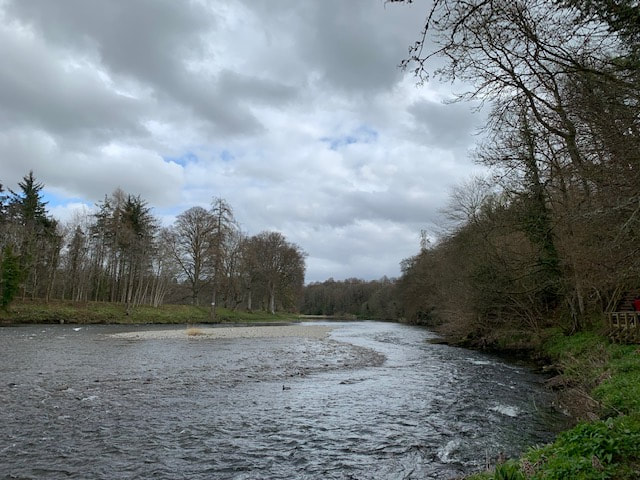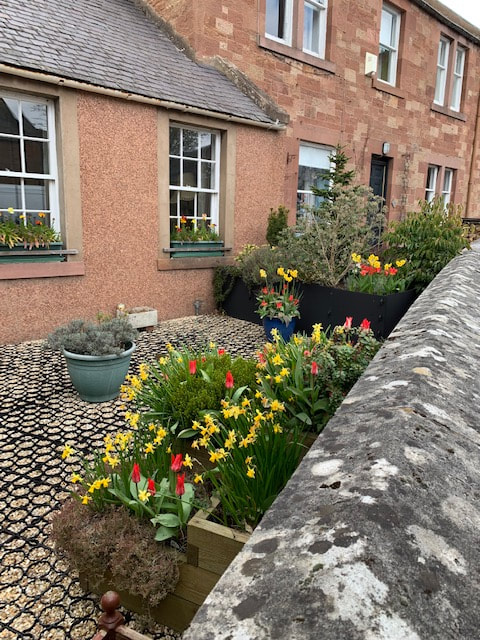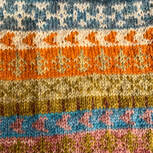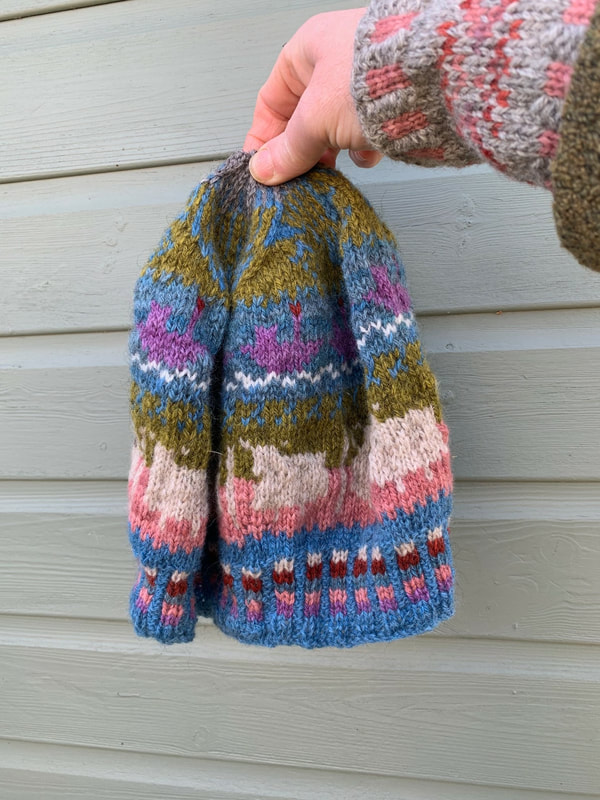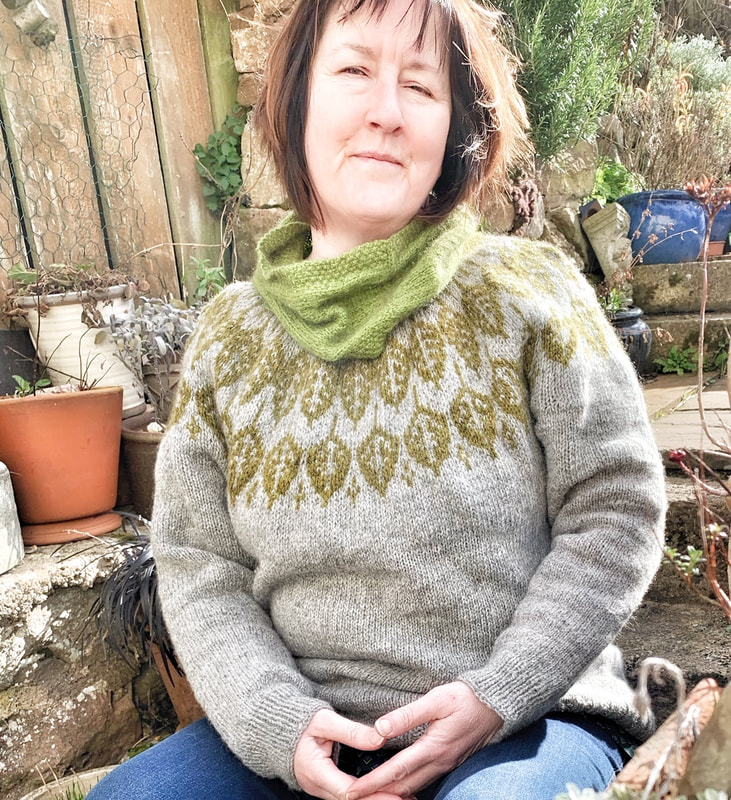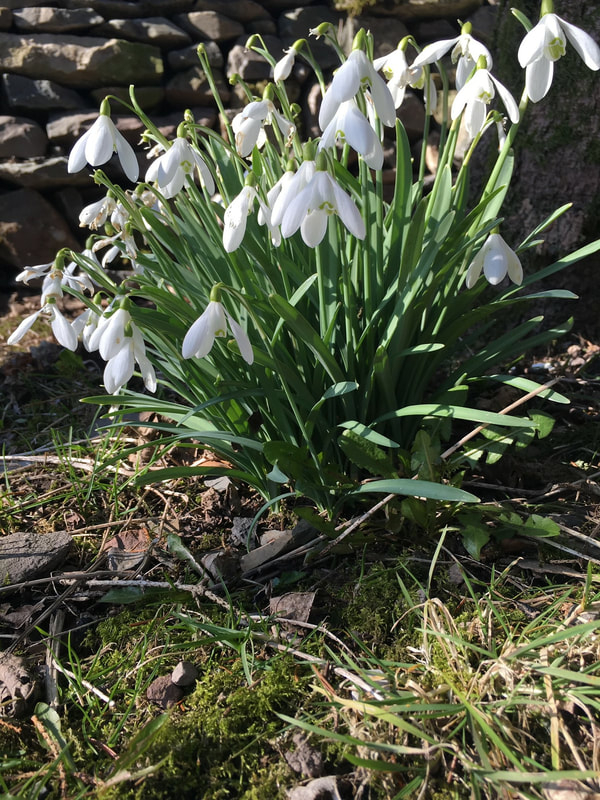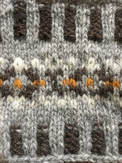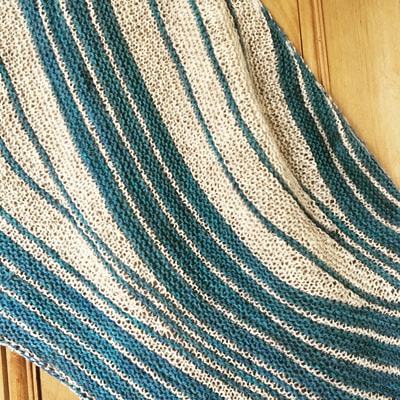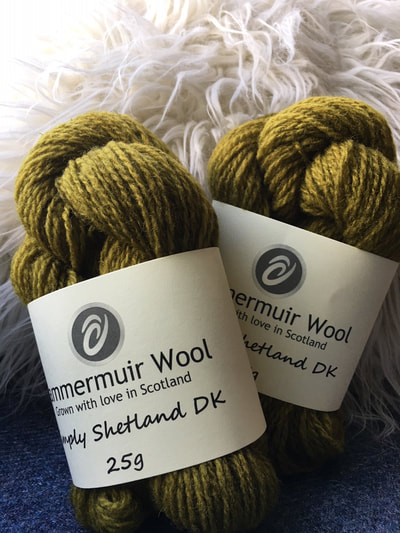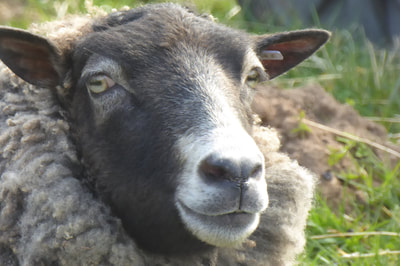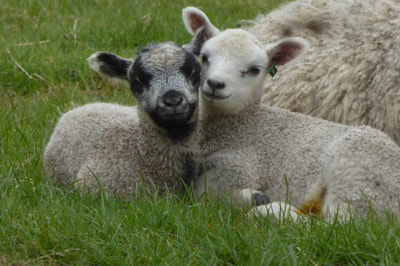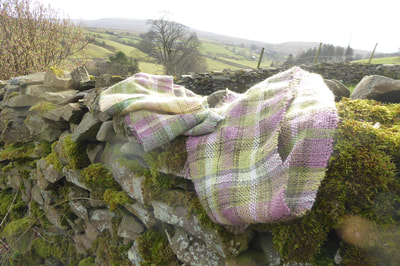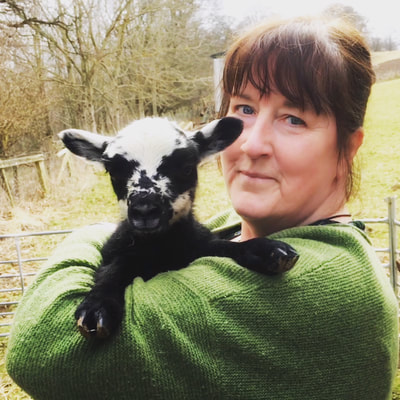|
Earworm of the day: The rhyme of Fair Maid Lilliard (see below), Midnight Feast by Lal Waterson The second day of the walk covered from St Boswells to Cessford, and was the start of the walking trip 'proper' (ie/ walking each day). I had originally planned this walk to be a solo project for a couple of reasons: 1) I've had a rough couple of years health-wise and had started to feel as if I'd lost myself a bit. Lost sight of the woman who would travel the world, or who would climb hills, alone. I'd become less independent, and I wasn't sure if this was a by-product of my being less financially independent, part of getting older, or just having been ill at times. I suppose I wanted to prove that I could still do it; still go it alone. 2) I wanted to spend some time connecting with the land that I spend so much time in - and I felt (rightly or wrongly) that that could be best achieved alone. I wasn't even sure what I meant by that connection: an understanding? an awareness of its rhythm? a feeling of being 'at one' with my surroundings? It's hard to pin down. And of course, I wasn't really planning to be alone, was I? I would have Hamish - our neurotic, nervy, rescue terrier of mixed breeding, who would happily lie on the sofa all day and has to be dragged bodily out of the house on walks. But - once out and about he commits himself to any walk with utter enthusiasm and delight. I also think that people might give a lone-woman-walking a second glance, but don't cast a second look at someone out walking a dog. A dog can simultaneously render you invisible, but also provide a point of connection with other people (and their animals). I could talk to Hamish and sing to him (and frequently do). Whether he understands, I'm not sure. Anyway - it was good to have P's company but it meant re-jigging my planned route to accommodate his work commitments. My original plan was to do St Boswells to Jedfoot one day and then Jedfoot to Morebattle the next, followed by Morebattle to Hethpool. P's need to be at work first thing on Day 4 meant we needed to do St Boswells to Kirk Yetholm over two days and Cessford seemed the earliest natural place to break the mileage up. With the result that Day 2 was a long day and we thought we'd walked about 15 miles but not sure. The fitbit clocked in at over 40,000 paces (it has never done that before and I thought it might self-destruct). This day of the trip was also a Sunday - about a fortnight after the first section. Given that I was sleeping at home again that night, I didn't need the full kit. The Walk: St Boswells commemorates St Boisil, who was prior at Melrose Abbey when St Cuthbert was a young monk. I had been re-reading Bede in preparation for the Way, and Bede states that Boisil: 'gave him instruction in the scriptures and showed him am example of holy life'. Boisil also foretold that Cuthbert would become a bishop. St Boswells is an easy trip down the A68 for us and in fact we were too early for Main Street Trading which doesn't open until 11am. We took a fantastic brunch in the dog-friendly Buccleuch Arms and picked up leaflets which promised us a free half-pint in the Templehall at Morebattle the next day. We had a brief route discussion and decided to walk to Maxton (the next village along the Way) by road to save some time. We'd had a taste of the Tweedside path, on the previous day, and were keen to come and do a thorough walk around the Tweed later in the summer. The green at St Boswells was a huge - and interesting-looking - car-boot sale (fund-raising by the Community Council) and we walked past it to pick up the A699 at the back of the green, where it headed off towards Kelso. This is a short walk (just over a mile) but the road was busy and Hamish is not keen on speeding cars. Every time something whooshed up behind us he would leap into the air and then try to lunge at the vehicle as it drove away. I gripped him tightly on a very short lead and put my head down. When we arrived at Maxton we met our first St Cuthbert's Wayers of the trip - these men were walking the Way from Holy Island towards Melrose and were just debating heading into St Boswells by road rather than via the river. It seemed they planned to be in Melrose later that day for their trip home. From Maxton, the Way continues along a quiet lane back towards the A68 which you could hear as we got closer. As we left Maxton, we could see that the Eildon Hills still looked quite close: ... and we keep wondering (even now) what that big white building on the side of the Eildons is - a bit of an eyesore and very noticeable. Almost immediately before reaching the A68, St Cuthbert's Way disappears into some trees on the left, picking up Dere Street, the ancient Roman Road which ran from York to the Firth of Forth. To me, it felt like like this is where the Way began and I was particularly looking forward to this section. To be fair, it's hard to shut out the noise of traffic on the A68 at first and you pick your way through young geans along the back of some houses, some pony paddocks and the famous A68 Shed Shop, but gradually the path starts to swing away from the road and things got quieter. We found this wee creature lost in the woods: The very thought of walking along Dere Street had to stir ones imagination. Until reading up in advance of the Way, I hadn't thought about the name Dere perhaps coming from the kingdom of Deira (where York now is), but had certainly thought about the Romans (or more likely their slaves) who had built this road, through the Cheviots and into the lands of the Votadini, wondering how they coped with Scottish winters and long dreich darkness. I had come across Dere Street at Soutra, where it passes by the ancient infirmary before heading down towards Edinburgh and the Firth. Initially, the route didn't feel very Roman, it wound its way through young trees full of cherry blossom and alongside a vast field of golden rapeseed - perhaps destined to make some beautiful Borders Rapeseed Oil. But gradually the walk opened out into a gorse-filled ride, full of heady coconut-scented yellow brilliance, and edged by trees where chaffinches, sang, chiff-chaffs chiff-chaffed, and a greater spotted woodpacker drummed somewhere hidden. Somewhere there was an altercation going on between a hungry buzzard and some protective crows, and the sound of skylarks just poured down out of the heavens - drenching us in song. It was truly wonderful. P and Hamish were off ahead, and I just fell into a smiling meditative trance where just being there, at that moment, was a real joy. That was what I wanted my walk on the Way to be. I couldn't stop smiling. Shortly after this glorious stretch, we reached Liliard's Edge and Liliard's Stane. I had been looking forward to this. An interpretative board sets out the history of the spot, and tries to separate out legend from fact. What we do know is that this point, midway between the great valleys of the Tweed and the Teviot, was known as Lilyot's Cross, a place where wardens of the English and Scottish Marches met to settle disputes. The legend of Fair Maid Lilliard comes from the later Battle of Ancrum Moor in February 1545, during the Rough Wooing. I'd been thinking about the Rough Wooing recently; Haddington was beseiged during a later battle in the same war with Scottish forces shelling the town which had been seized by English forces. St Mary's Church was heavily damaged. Anyway, the Rough Wooing was an attempt by Henry VIII of England to ensure that the young Mary Queen of Scots (his great-niece) was betrothed to his own son Edward so that the Tudors could gain control of Scotland. As it turned out Mary married the Dauphin instead which hacked Henry off further. Much of southern Scotland was invaded by English troops, many Scottish towns were destroyed and the impact on ordinary Borders folk must have been immense. The Battle of Ancrum Moor took place after English forces invaded Scotland, plundered Melrose and started to head back south 'laden with spoils'. Hastily gathered Scottish forces in smaller number met the invaders and a pitched battle ensued ending with victory for the Scots. Legend has it that Fair Maid Lilliard - having seen her lover hacked to death, picked up his weapon and fought until she too was killed. Her grave is said to sit on top of the hill with a plaque commemorating her achievements: You can't help but say 'what a woman', true or not. And this wee ditty became my earworm. Recited in time with my steps as I strode along, full of sunshine, birdsong and joy. From the grave on top of the hill you can clearly see North (backwards) and South (forwards) to the Cheviots and the English border. From Liliard's Edge, we walked for miles gently downhill, with the Waterloo monument at Peniel Heugh to our left, a monument to yet another more remote battle. Crossing a minor road we started down the south facing slopes of the Teviot valley and into a warm, earth-scented, bluebell-filled wood to the grounds of Monteviot House. The air was warm and this was the first time I had been in a bluebell wood for a very long time indeed. I had forgotten the brilliance and the scent. As we descended further, the paths filled up with people wandering, standing, chatting, and just generally dawdling. We decided on a detour for ice-cream at Harestanes Visitor Centre. The cafe here is also dog-friendly although it was so hot that we sat outside. After Harestanes, the Way is well-marked and takes you on a circuitous route the long way around the edge of the grounds of Monteviot House. The grounds do have some magificent trees! Eventually you reach the banks of the Teviot and cross it via a very narrow, swaying, springy, shoogly footbridge. Along the river bank downstream, then up through some trees to Jedfoot Bridge, close to where the Jedwater joins the River Teviot - and this is where I had originally planned to be collected. I'm just putting that here. By now my right foot had started to hurt. I unlaced boot and removed socks and waved my foot at P. Any blisters? He said he couldn't see any. So I limped on . This was a a mistake and I should've ignored him and put a Compeed on at that point. From Jedfoot Bridge and the speedy A698 (also to Kelso), the Way heads south back on Dere Street, which it this point did look as if it might have been an ancient road. By now it was after 4pm, and very very hot. The route follows the old Street to the top of the hill, where we rested on a very welcome bench, and then leaves the Border Abbeys Way (which heads for Jedburgh nearby) before heading left into a beech wood. This was the general pattern for the next wee while, as the path contoured along the top of the Teviot Valley, heading roughly south east. A spell of wood walking through Chestercleuch Plantation, where I found another wooden staff to support my aching feet, followed by an uphill stretch on a lane and then another track down to cross the Oxnam Water as it, too, flowed down to the Teviot below. then up through steep, intensely green pasture, and up a punishing track to another stretch of woodland at Blindwells Plantation, another uphill road stretch to Brownrigg where the Way crosses to the back of some cottages before rising towards Cessford Moor. A couple were enjoying the Sunday evening sunshine on their back patio, he with cold beaded pint and she with a very chilled-looking glass of white wine. I wanted to collapse and cry. 'Ha ha,hi - got one for me?' 'Oh ha ha fine evening for it - you've a fair way to go'. Mutter mutter, down another field, across another burn and then a climb up through woodland where I seemed to get a second or fourth wind. A quick check of the map confirmed that this was the last uphill stretch of the day. We would soon be able to see Blakeman's Crag at the top of the hill, then we would be across the top and downhill to Cessford where we had left the Defender. The sun was still warm but getting lower as we passed the final plantation and headed down a track towards Cessford - all of a sudden, the Cheviots seemed much closer and I realised that we were nearly half-way through the walk. Crawled into the Defender and headed back to St Boswells - passing a few of the road stretches we had done along the way. Blimey we had walked far.
Debating on whether to pick up a fish supper in Earlston or Lauder, we chose Scotts View in St Boswells. Massive mistake. It was officially the second worst fish supper I have ever had. A lukewarm bottle of water accompanied food which lay swimming in a pool of oil at the bottom of the container. The chips were only partially cooked. This was a fantastic day's walking but had played havoc with my right foot. P's feet okay. Dog okay.  Berghaus 45 litre rucksack: I packed this over my slightly larger rucksack as this one has more pockets so I could keep things better organised:
In main bit of sack or on me: Waterproof trousers (craghoppers) Waterproof jacket (Berghaus) Woollen beanie Liner gloves I only needed the above items on one of the days Bivi bag wee folded up sitting mat. 1 buff St Cuthbert's Way Cowl Cloth sunhat (mountain warehouse/MW) Sunglasses Scarpa walking boots Pair trainers 2 pairs liner socks 2 pairs bridgedale walking socks 2 pairs walking trousers very lightweight from MW Thin fleece (only wore on one day) so carried in straps of rucksack Thin hoody which I ended up wearing all the time over a t-shirt 2 thin t-shirts and one shirt PJs Thermos Lunch items Large water bottle Dog food in pre-weighed out portions Dentastyx Hamish's bedding (an old duvet cover) My own medications & some emergency stuff like a couple of cystitis sachets, diclofenac, ibuprofen and eye drops in a tiny pouch. Toiletries (soap, shampoo sachets, bath-shower gel sachets, mini-moisturisers, deodorant, foldable toothbrush and mini-toothpaste. contact lenses) SHOULD have taken hair conditioner as at the end of the week I looked like a scarecrow. First Aid kit (with additional compeed plasters) Underwear Side pocket: Hamish's biscuits, foldable bowl, dog-poo bags, hand-sanitiser Side pocket: Smaller water bottle Top pocket: Specs, sunscreen, insect repellent, phone charger/lead, purse, Front pocket: Book (Beowulf), guidebook, OS maps, whistle and compass My pockets: Phone, tissues, guidebook-issued map in case, lipsalve. There is nothing that I would have left behind. Stocked up on extra compeed in Wooler (chemist open until 6pm). Introduction: I've never written a blog about a walk before. So I'm not very sure how to do this. I want to include a lot of photos, some practical stuff (in case you want to walk this Way too, and some thoughts that I had while on the trip. As it turns out there might be quite a lot about feet. Some basic information about the Way. It is 100 km (or 60 miles) long/short and stretches between Melrose and Holy Island (or vice versa). It is incredibly well waymarked throughout, and contains a real mix of terrain. The amount of road-walking has been reduced since the Way was launched, which is all to the good. I remembered reading about the life of St Cuthbert in Bede's Ecclesiastical History of the English People - and felt I had absorbed a lot about him through previous visits to Lindisfarne and Melrose. Given his affinity with animals I had always viewed him as like St Francis, but with less effective PR. Summary of my experience? Incredible. Hot. Very very sore feet. Fantastic people. Not many people. Nice gins. Great finale. Sixty miles doesn’t sound a lot (but 100 km sounds more) and the Way certainly isn’t long in comparison to more well-known routes such as the West Highland Way, the Pennine Way or the Southern Upland Way. But it would be a Big Deal Indeed for me – as the autumn’s enforced inactivity (detached retina) and then just General Laziness had reduced activity levels to zero beyond checking the sheep once a day. I had originally planned to do this walk alone. It's one of my Big Goals for 2019: along with losing a specified amount of weight; getting some more Munros under my belt, a night wild camping and a night in a bothy. However, I've realised that it's good to have other people along for some of the time. My main concerns about the walk in advance were: 1) having to walk so far each day that I had to rush and thus not be able to absorb where I was. So I made some quite short days and thought about where I wanted to spend more time. I didn't always get this right. P weighed in later on and changed the route which meant we ended up with quite a long second day. But that’s okay as I made sure to remind him at regular intervals about whose decision it had been. 2) getting very wet. As it turns out not really a worry 3) having to carry too much - so I really thought about what (not) to take. 4) having to talk to people. We seriously considered making a 'Don't Talk To Me, I'm On A Silent Pilgrimage' card that I could wave at anyone I didn't like the look of. I spent a long time thinking about the walk in advance: read up on it, read accounts of other people's walks, studied maps, spoke to a good few people who had walked the route, checked out the pubs and cafes along the route to ascertain levels 0f dog-friendliness in advance. Bought some new walking clothes from Mountain Warehouse and from Ebay (so I wouldn’t be mistaken for a vagrant) and broke in my newish Scarpa boots. Did lots of walks in the Lammermuirs and around the Tweed and Teviot. These are my boots. I love them. Despite all the pain and heartbreak on the Way. And my trusty old backpack (which is heavy even when empty, along with the St Cuthberts Way Cowl (which it was too hot to wear). Melrose to St Boswells (1/2 day) Earworm of the day: Poor Man's Son by Kris Drever I did this with P which involved the judicious use of two cars. Living so close to the start of the Way I preferred to return home at night for as long as I could. Would save on costs too. The first day was Melrose to St Boswells - a short walk which broke us in to the route, and to the rhythm of walking. It was a very very hot day, but filled me with enthusiasm for the route ahead. Given the presence of P, refreshment stops featured heavily and assumed great importance as regular breaks are essential to keep him going. Parking in the centre of Melrose, we started out at Apples for Jam, a dog-friendly cafe which is open seven days a week. Well worth a visit. Had an amazing veggie breakfast and great coffee. Wondered if I was dawdling in the cafe on purpose. The route from Melrose started from the square, up Dingleton Road and then took a left at the end of some houses and past someone's wheelie bins. From there it is an unrelenting climb up the side of the Eildon Hills. There are LOTS of wooden steps which are covered in wire mesh which Hamish Dog hated, and then some bits of uphill path. It was hot, I was gasping for my life (or so it seemed) and I wondered if it was possible to just cancel the whole walk and just Never Mention It Again. I really can't do hills. It's a lung thing. i can walk for ever on the flat (feet permitting) but an incline is enough to turn me into a gasping wreck. But the views back over Melrose and up onto the hill tops opened up quickly and the coconut scent of gorse was everywhere. Such a heady, head-filling, sweet sweet scent. In quite a few pictures P is on the phone. It was a Sunday and Celtic were playing. It's Very Important to allow him to check the scores. :) We could see across to the Lammermuirs on the far horizon. This is always good as the Lammermuirs are home and I referred back to the Lammermuirs whenever I could see them. The waymarking is good - and for the first part of the walk we were sharing the signposts with markers for the Eildon Hills Path. The Borders has a really good network of paths centred on each of the main towns in the region. Yes I am still calling it a region ... The top of the hills was filled with runners -it's a popular venue for races throughout the year, for people who are a LOT fitter than us. Clad in day-glo vests, they seemed to float over the slopes all around us - criss-crossing the paths and making it look so easy. I used to have dreams that I could run: it's something I've always wanted to be able to do. Dreams that see me tackle mile upon mile with ease, hurdling fences and hedges. The tops of the Eildons are stunning but, as it was so so busy, we pushed on. At the saddle between Eildon Mid Hill and Eildon North Hill the view to the south suddenly opened up, with Peniel Heugh, Wideopen Hill and the Cheviot all visible. They seemed a long way away indeed. Impossible to think I would get there and beyond on foot. The walk down the southern side of the Eildon Hills was beautiful, through heady-scented gorse and then straight, burly beeches, along an old path. I found a 'staff' and thought I would channel St. Cuthbert. I suspected he might have had a donkey for the steep bits. It was St Aidan who gave his donkey away, after all. No body mentions St Cuthbert doing the same. A quick dip into a shady glen, then up a pink slope through trees (more steps, more mesh, more canine dischuffment) and across some open ground and down to Bowden. Bowden was new to me. Tucked away behind the Eildon Hills with some friendly inhabitants. I stopped to chat to a lady who was out walking a very hot-looking golden retriever, and to another lady who was tending a friend’s garden. P waited by the well in the centre and checked the football scores again. I was smiling as we met up – this was what I had hoped the Way would be like – peaceful, restorative, time to chat to strangers... The Cicerone guide to the Walk had suggested that we look out for Aird’s House. We didn’t see it but will visit at some point. However I liked the sign in the wee shelter, the well and the general look and feel of the place. Reminded me of Garvald where we used to stay, although it doesn’t seem to have a pub. The Way took us down out of Bowden and along the Bowden Burn through some trees. Eventually emerging up above the valley and on the road to Whitelees Farm and cottages. Then a first spell of road-walking in the heat down the hill to Newton St Boswells. This spell brought us our first overtaking etiquette dilemma. Some people had overtaken us on the north side of the hills (at which point greetings were exchanged), then overtaken us again at the farm as I was re-lacing my boots. More greetings. Then we overtook them on the road (but only because they stopped for water). More greetings. Now what? This was getting awkward and we were running out of new ways to say ‘hello’. The only thing seemed to be to stay ahead of them for the rest of the walk although this would probably not be easy. We stepped up the pace a bit and they closed the gap. At St Boswells, they headed into the village to find sustenance and we ploughed on. I read somewhere that people had found it hard to find the signs through St Boswells but it didn’t seem difficult. Look for green signs on the walls of buildings. We took a path down behind some houses and I managed to find another gardener to chat to. Everyone seemed bowled over by the amazing weather and it wasn’t even Easter yet. The path took us under the A68 and it made me smile to think of all the times I’d driven overhead, not knowing the path was here. Sheltered beneath trees the path finally moved away from the Bowden Burn and we got our first view of the Tweed, the path rising and dipping along the river until we reached a viewpoint back up the river towards Melrose, and a welcome bench. At which point our pursuers overtook us again with a cheery 'hello'. As we headed along the back of the Tweed Horizons Centre, the path stepped down to a road end at a bridge crossing the Tweed, and the place to head across if you wish to do the detour to Dryburgh Abbey. Some cars were parked up and people strolled about, walking dogs, exercising children and pushing buggies.
It was a bit busy for us, so we headed on along the path and eventually clambered up into the back of the main street in St Boswells, just along from the wonderful Main Street Trading Bookshop (and dog-friendly cafe) which is open seven days a week. Coffee and cake felt well-deserved (although we had only completed 7.5 miles/12 km) and managed to bag two wonderful books including The Hidden Life of Trees by Peter Wohlleben and The Running Hare by John Lewis-Stempel. Being able to read both of theses books ahead of the rest of the Way, enhanced my thinking about what I saw and the glorious trees and widlife which were to come. Last summer we made a decision: that we would not lamb in 2019. Lambing is something that we've always done and it does feel strange not to do it. However, it has freed us up to do LOTS of things that we wouldn't otherwise get to do: LOTS of gardening (including getting on top of the veg plot in plenty of time for a change) LOTS of days out in the recent good weather And I am planning to walk the St Cuthbert's Way next week. This is a big undertaking for me as I have completely lost my hill-walking mojo in recent years and this walk will be a challenge for me in terms of its (moderate) hills and the (moderate) distances involved. This is the route: And - I'm lucky to live close enough to come home and sleep in my own bed the first couple of nights.
And I've had to do lots of planning: booking accommodation which means I don't have huge distances to cover; sorting out tide times for the last day crossing over to Holy Island; wee bits of shopping; and of course lots of walking in my newish boots. I also decided to knit myself a cowl for the trip as a kind of meditation on the walk - and worked up a design which used up lots of the 'peerie clews' from my knitting basket. I loved knitting it. and you can see the basic design at the top of this post. I tried to design and work in lots of motifs from the walk as well as some of the predominant colours: blues, greens, pink, purple, yellow and brown with bits of pale grey. I'll try to knit another one that's better :) and post up the pattern. I've also said I'll post a record of the trip so I might have to hijack my woolly blog for the next wee while. We were so so honoured to be awarded a place at this year's Make:Wool event. This is an additional part of Edinburgh Yarn Festival, aimed at showcasing the work of those of us who produce wool from our own sheep (last year it was called Meet The Shepherdess) and so those of us who sell yarn with absolute traceability and provenance. It was so busy for us last year, that we sold almost everything we took (lesson for this year is to take more stock along with us!).We HAVE been let down by the Mill at the last minute, and so still don't have any of the 2018 wool clip to sell but we have been busy dyeing, skeining and labelling everything that we have, to bring to the event.
We will have: Laceweight (equivalent knit to a Jamieson's Ultra) both dyed and undyed. 4-ply ( equivalent to a jumper-weight) in Essy (pale grey Shetland and Romney blend which is sooo soft!) and Mountain Hare white. Hand-dyed 4ply in a rainbow of shades (as can be seem in the hat above!)There is both white and grey dyed wool giving a lovely mix of shades. DK in Haar (mid grey) and in a range of four hand-dyed-on-grey shades. which are ideal for knitting the Arboreal Sweater (see below). As you will see, we've been busy knitting for EYF and thanks to everyone who's helped out.! Well, the snowdrops here are not quite as advanced as this - it's a photo from last year, but they ARE starting to show their heads above the surface; the bravest of the flowers.
January has been a time for several things: business planning for the year ahead; getting applications in to yarn festivals around Scotland and the North of England; and trying to be kind to myself. Years ago, at business school, I remember looking at marketing as being a mix of Product, Price, Promotion and Place - and it has been useful to force myself into applying that kind of structured thinking to my own work. Lammermuir Wool has applied to several shows - and we should hear back from most of them over the next few weeks. The biggest news though has been being accepted for a place at Edinburgh Yarn Festival's Sunday event Make:Wool on 24th March. This is a development of last year's Meet The Shepherdess event which was the busiest event we have ever attended - a very busy four hours indeed. If you are coming to EYF, or are in Edinburgh on 24th then please do get tickets for the Sunday event as we'd love to see you! We made a decision NOT to lamb this year - as last year was so difficult. Eleven years in and we thought we would take a spring off-duty. So, no lamb pics to come this spring. Over the winter, there is less grass for the sheep as it won't grow again until the temperature picks up. They are fed hay each day and the quality of last year's hay has been superb - the sheep love it! Later on they will also get hard feeding, and they also have fodder supplement via a mineral lick bucket. They are certainly well provided for. Grass is their favourite though - and even in the snow, they will dig down to find grass. Last year's fleeces are off to the Mill in Yorkshire and it will be a stressful few weeks trying to get it back in time for the EYF event! We have additional fleeces in the mix this time, too - following the success of last year's Shetland/Romney blend: Essy 4 ply. We have been lucky to purchase fleeces from a championship winning flock in Aberdeenshire, as well as from a neighbouring flock of Shetland sheep. Next year's clip will also be blended with local Cheviot fleeces: all to expand the range and amount of yarn that we have to offer. Looks like all the dreaming and planning is paying off... I was never just going to be able to follow patterns. Years ago, i studied dance as my minor at degree level and it used to make me think about the merits or otherwise of learning a range of techniques before launching off into creating your own projects. There is also something to be said for recognising the strength and beauty of the traditions from which your creativity comes.
And so it was exciting to just get out a pair of needles and some left-over yarn and start to think about what I might like to wear myself. Wanting to stay close to the origins of my home grown Shetland wool. All of the yarn in this sample shown above are undyed natural shades of sheep apart from the hand-dyed strip across the middle which is a shade called Gloaming. Before I knew it, my hands had knitted up a wee pair of very warming cuffs and I have only just managed to deconstruct and reconstruct what I did so that i can write it up into a pattern. This pattern will be included as part of some yarn kits that I'll have for sale at St Abbs and afterwards on the website. Scary and exciting times! World Mental Health Day is held on 10th October each year and it's important to me for two reasons: Firstly because for nearly ten years I worked for 'see me', Scotland's national and multi-award-winning campaign to end the stigma and discrimination of mental ill-health. Latterly as Director of the campaign. WMHD (and mental health week) provided a welcome focus for local and national campaign and lobbying work - , work which went on all year without always making the headlines. Secondly because for the last twenty years or so I have come to a recognition and acceptance of my own mental health challenges and learned better how to be more resilient, and how to take care of myself when things become difficult. There is also now mere awareness in Scotland of Adverse Childhood Experiences (ACEs) and the impact that they have on us as adults. Not before time and very welcome. My mental health is definitely better these days: finally finding a good GP, the right medication, and a different way of living have made all the difference. Being self-employed is not without its challenges for someone who is extremely diffident, but stepping away from the mental health charity which employed me is the best thing I ever did for my mental health. Now my life is less structured (unless I'm working on a project for a client in which case I am mega-disciplined!) and more focused on the things I enjoy doing. These are: - being with my sheep - working with the wool that they produce (whether that is knitting, crochet, weaving and - more recently forays into hook-rugging and needlefelting) - walking outside and foraging - scouring charity shops and eBay for clothes (have decided that buying new is a mug's game) - coming up with creative ideas for the business - reading Scandi and Scottish crime - painting in watercolurs - pottery (a constant and felt absence in my life while I try to get on top of things woolly) - talking to people about my wool and my sheep. I am aware that I am incredibly lucky at present to be able to live life in this fashion: in a way that is good for me, good for my relationships and my mental health. |
Archives
January 2024
Categories |
Proudly powered by Weebly

